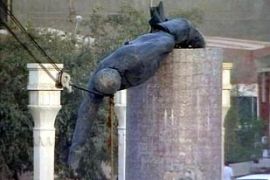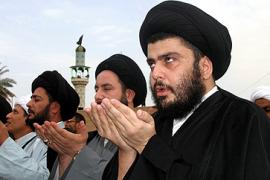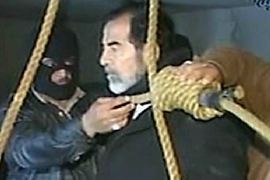Timeline: Four years of turmoil
Breakdown of major developments in Iraq since the fall of Baghdad on April 9, 2003.

August 19: Bomb attack on UN headquarters in Baghdad kills 16.
August 21: Saddam’s cousin Ali Hassan al-Majid, known as Chemical Ali, is captured.
August 29: Najaf car bomb kills 125 people, including Shia leader Ayatollah Mohammed Baqr al-Hakim.
December 14: Saddam Hussein is captured in Tikrit.
February, 2004: More than 100 people killed in Irbil in suicide attacks on offices of main Kurdish factions.
March 2: Suicide bombers attack Shia festival-goers in Karbala and Baghdad, killing 140 people.
 |
|
Muqtada al-Sadr prays with followers in Najaf |
April-May: Fighters loyal to Shia cleric Muqtada al-Sadr fight coalition forces.
June 28: Iraq’s US-occupation administration transfers power to the interim Iraqi government in a surprise move two days ahead of the scheduled handover.
August: Fighting in Najaf between US forces and supporters of al-Sadr.
September 21: Kofi Annan, UN secretary-general, delivers a stern rebuke to nations that “shamelessly disregard” international law. The previous week, he branded the US-led war on Iraq as illegal.
October 6: The US Iraq Survey Group announces that 15 months of searching have uncovered no evidence that Saddam Hussein possessed weapons of mass destruction.
November 16: British-born charity worker Margaret Hassan is killed by her kidnappers.
December 17: Colin Powell and John Snow, US secretaries, sign agreement with interim Iraqi finance minister cancelling Iraq’s $4.1 billion debt to the US.
January 30, 2005: An estimated eight million people vote in elections for a transitional national assembly. The Shia United Iraqi Alliance wins a majority of assembly seats. Kurdish parties come second.
February 28: At least 114 people are killed by a car bomb in Hilla, south of Baghdad.
April 6: Parliament selects Jalal Talabani, a Kurd, as president. Ibrahim Jaafari, a Shia, is named as prime minister.
May: Major increase in car bombings, bomb explosions and shootings, Iraqi ministries put the civilian death toll for May at 672, up from 364 in the previous month.
June 14: Massoud Barzani becomes regional president of Iraqi Kurdistan.
July 19: Study compiled by the non-governmental Iraq Body Count organisation reports nearly 25,000 Iraqi civilians have been killed since the US-led invasion.
August 28: Draft constitution endorsed by Shia and Kurdish representatives, but not by Sunni negotiators.
August 31: More than 1,000 people die in a stampede in Baghdad during a Shia ceremony.
October 19: Saddam Hussein is put on trial on charges of crimes against humanity.
October 25: Voters approve a new constitution, which aims to create an Islamic federal democracy.
December 15: Iraqis vote for the first, full-term government and parliament since the US-led invasion.
January 20, 2006: Shia-led United Iraqi Alliance win December’s parliamentary elections, but fail to gain an absolute majority.
February 22: A bomb attack on an important Shia shrine in Samarra unleashes a wave of sectarian violence in which hundreds of people die.
April 22: Jalal Talabani, newly re-elected as president, asks Shia compromise candidate Nuri al-Maliki to form a new government. The move ends four months of political deadlock.
May and June: An average of more than 100 civilians per day are killed in violence in Iraq, the UN reports.
June 7: Abu Musab al-Zarqawi, al-Qaeda leader in Iraq, is killed in an air strike.
September: A ceremony to transfer operational command from US-led forces to Iraq’s new army is postponed.
November 5: Saddam Hussein is found guilty of crimes against humanity and sentenced to death.
November 21: Iraq and Syria restore diplomatic relations after nearly a quarter century.
November: More than 200 die in car bombings in the mainly Shia area of Sadr City in Baghdad.
 |
| Saddam Hussein is executed [AFP] |
December 30: Saddam Hussein is executed by hanging.
January, 2007: George Bush, US president, announces a new Iraq strategy with thousands more US troops to be sent to increase security in Baghdad.
January 15: Barzan Ibrahim, Saddam Hussein’s half-brother, and Awad Hamed al-Bandar, former head of the revolutionary court, are executed by hanging.
January: UN reports more than 34,000 civilians were killed in violence during 2006, the figure surpasses official Iraqi estimates three times over.
February: A bomb in Baghdad’s Sadriya market kills more than 130 people.
March: Fighters explode three trucks with toxic chlorine gas in Falluja and Ramadi, injuring hundreds of people.
March 20: Taha Yassin Ramadan, former vice-president, is executed.